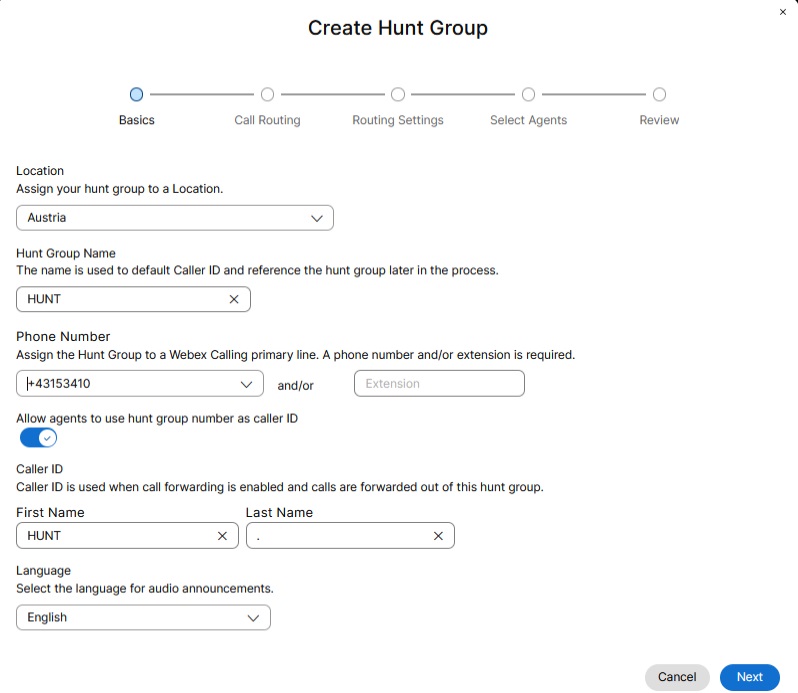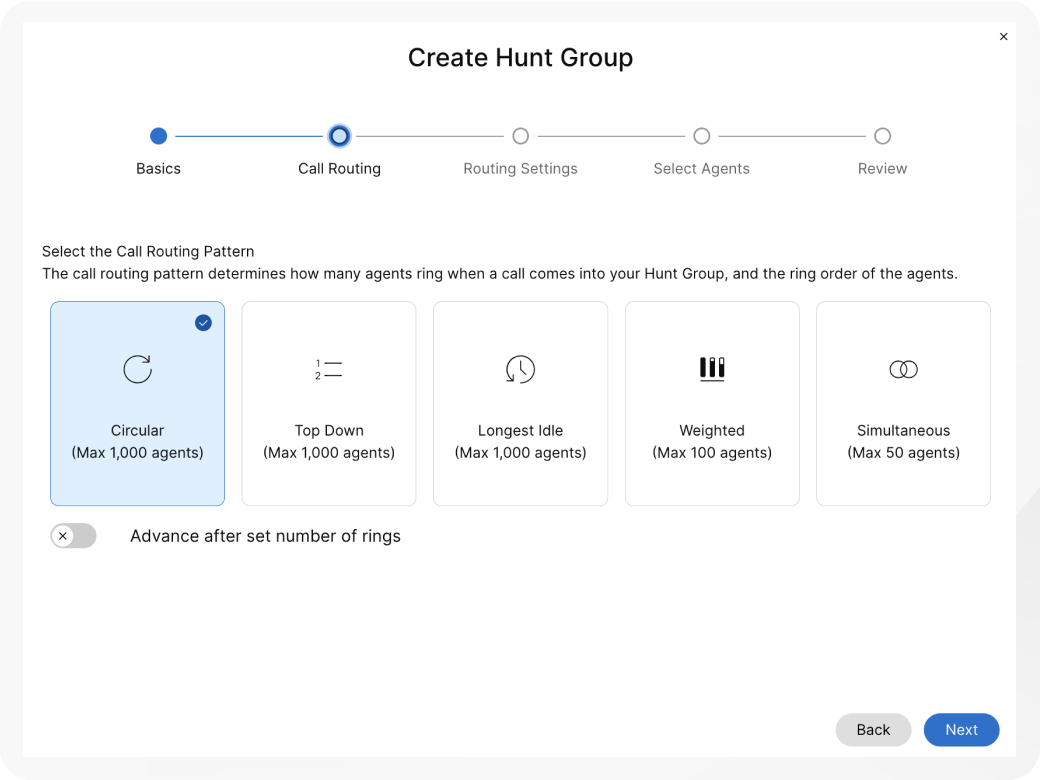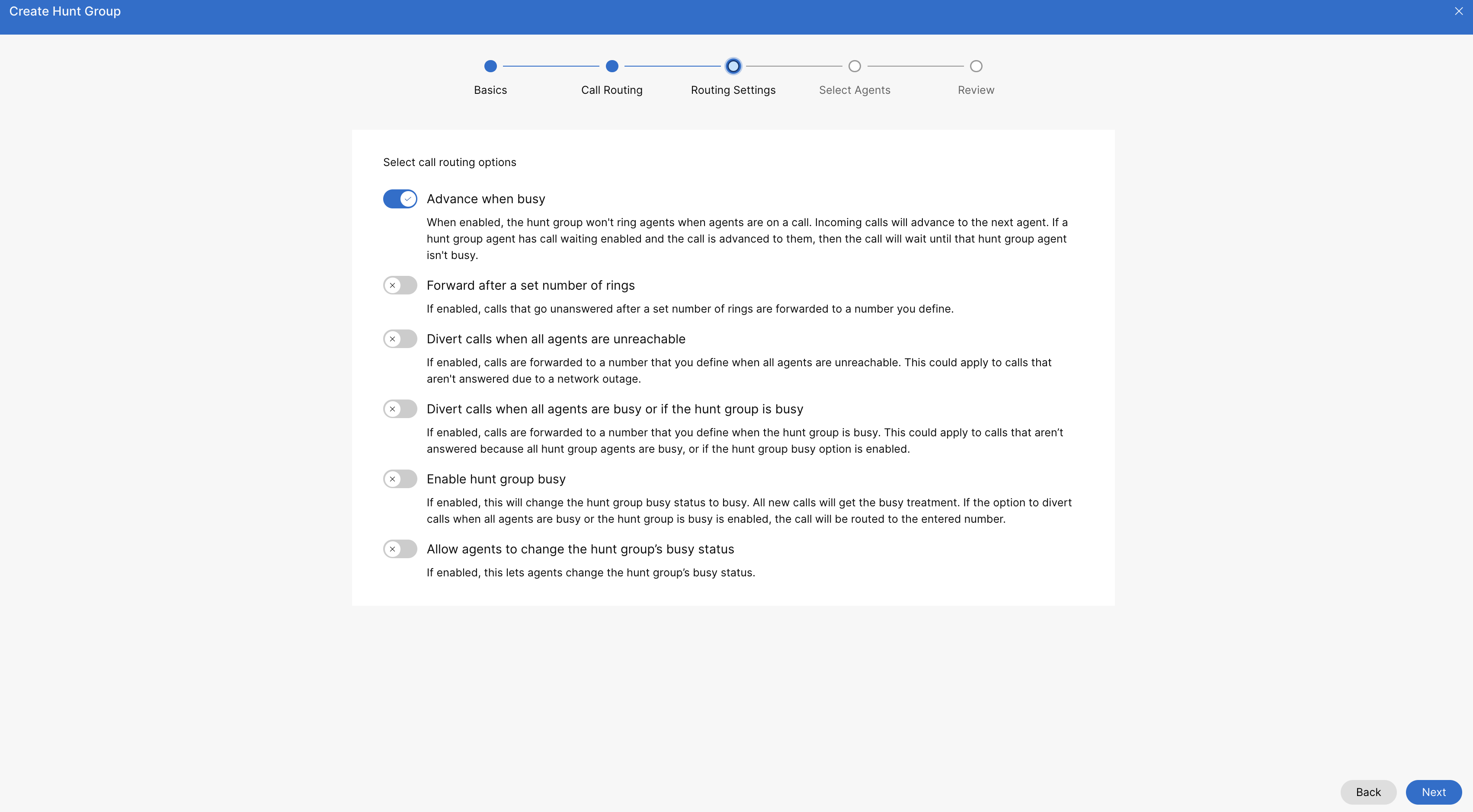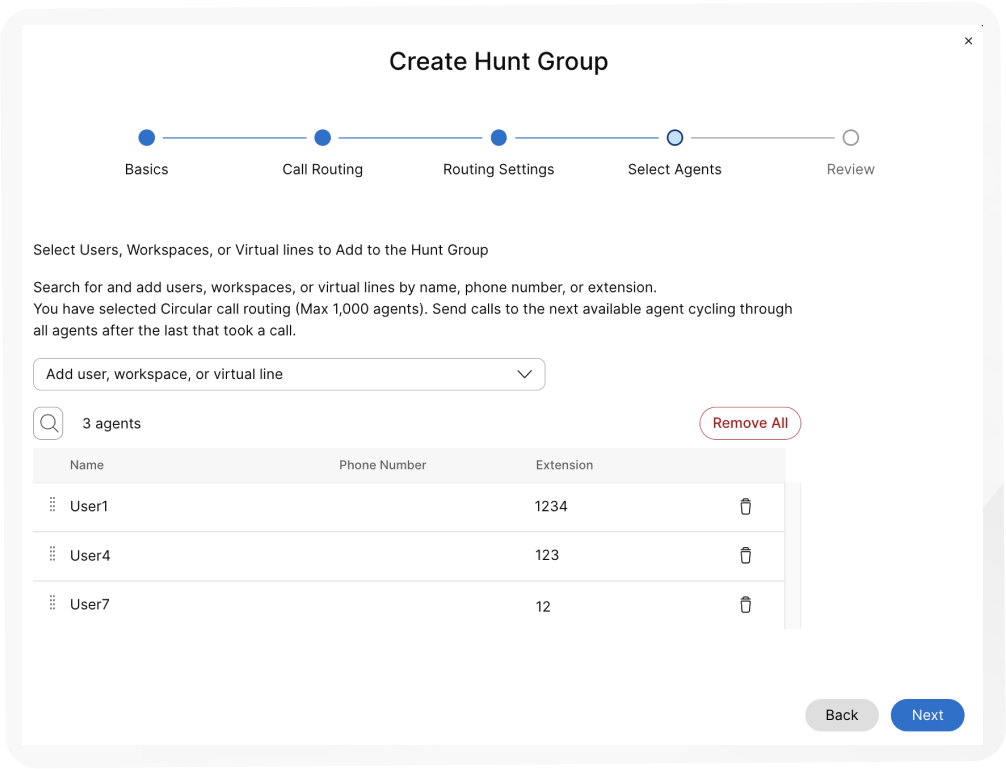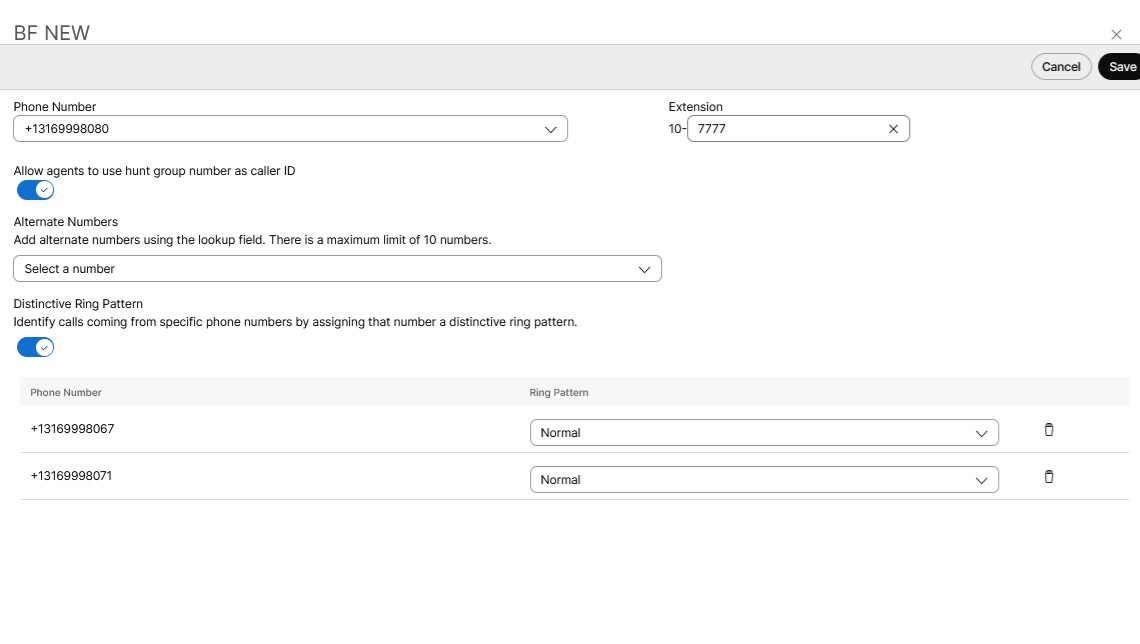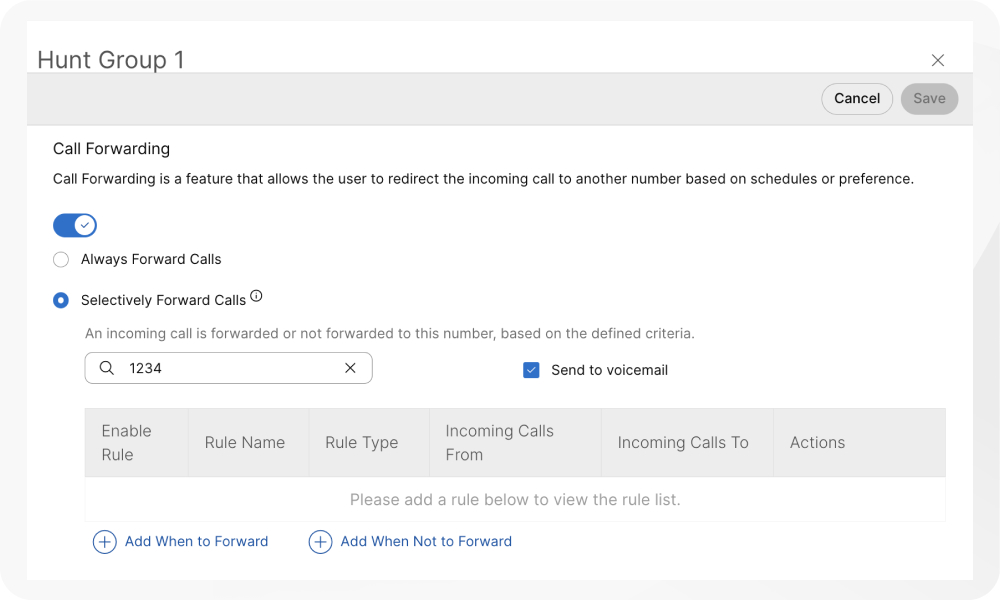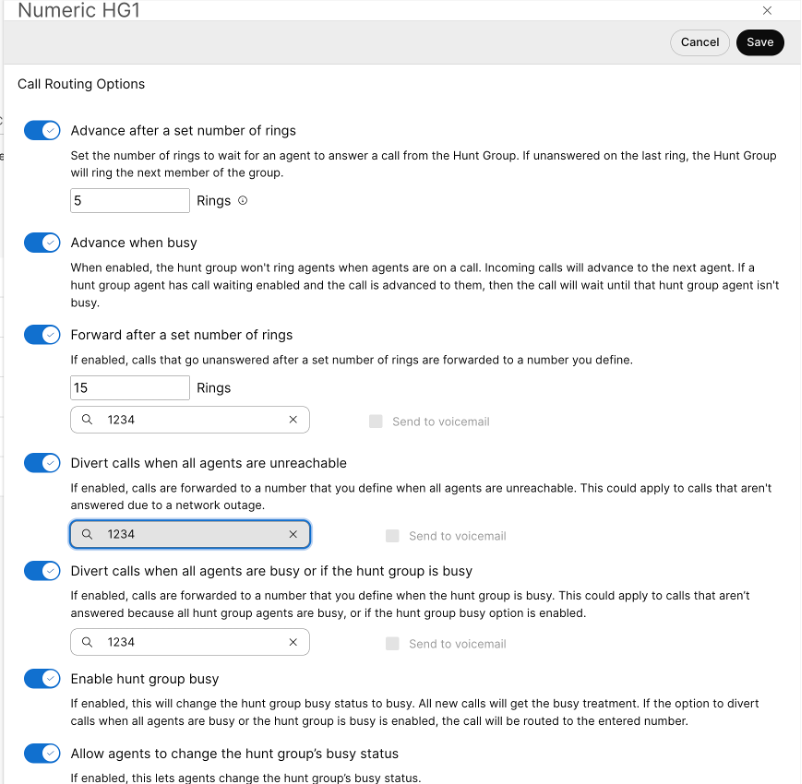- Home
- /
- Articolo


Gestione dei gruppi di risposta in Control Hub
 In questo articolo
In questo articolo Feedback?
Feedback?È possibile utilizzare i gruppi di risposta per assicurarsi che tutte le chiamate in arrivo riceveranno risposta dalle persone giuste o inoltrate alla casella vocale per una risposta successiva.
I gruppi di risposta indirizzano le chiamate in ingresso a specifici dipendenti in una sequenza predeterminata. La chiamata viene instradata assegnando un numero di telefono a un gruppo di dipendenti e definendo poi regole quali come rispondere alla chiamata, per quanto tempo la chiamata rimane in attesa e a chi inoltrarla.
Puoi impostare i gruppi di risposta nei seguenti casi:
-
Un team di vendita che desidera un routing sequenziale. Una chiamata in arrivo squilla un telefono, ma se non è presente alcuna risposta, la chiamata passa al gruppo di risposta successivo nell'elenco.
-
Un team di supporto che desidera che tutti i telefoni squillino contemporaneamente in modo che il primo membro disponibile possa rispondere alla chiamata.
Crea una gruppo di risposta
Quando un gruppo di ricerca riceve una chiamata e la inoltra a un agente, la funzione di inoltro delle chiamate dell'agente non funziona.
| 1 | |
| 2 |
Vai a . |
| 3 |
Vai alla scheda Gruppo di ricerca e clicca su Aggiungi nuovo per creare un nuovo gruppo di ricerca. |
| 4 |
Nella pagina Nozioni di base, immettere i seguenti dettagli e fare clic su Avanti.
|
| 5 |
Nella pagina Instradamento chiamate, seleziona una delle seguenti opzioni e fai clic su Avanti.
Se necessario, è possibile abilitare l'opzione Avanza dopo un numero di squilli impostato e impostare il numero di squilli da applicare alla scelta di instradamento delle chiamate.
|
| 6 |
Nella pagina Impostazioni di routing, abilitare una o più delle seguenti opzioni, se necessario, e fare clic su Avanti.
|
| 7 |
Nella pagina Seleziona agenti, cerca e aggiungi utenti, spazi di lavoro o linee virtuali all'elenco delle chiamate e fai clic su Avanti. A seconda dell'opzione Call Routing scelta, aggiungi informazioni come l'aggiunta di una ponderazione percentuale a utenti, spazi di lavoro o linee virtuali. Per l'instradamento circolare delle chiamate, trascina e rilascia utenti, spazi di lavoro o linee virtuali nell'ordine della loro posizione in coda.
Se a un agente viene assegnato solo un interno, assicurarsi che la sua sede abbia un numero principale. Senza un numero principale, le chiamate al gruppo di ricerca non vengono indirizzate all'agente con solo interno. |
| 8 |
Nella pagina Revisione, controlla le impostazioni del tuo gruppo di ricerca per assicurarti di aver inserito i dettagli corretti. |
| 9 |
Fare clic su Crea per creare il gruppo di ricerca. |
Guarda questa dimostrazione video su come creare un nuovo gruppo di ricerca nel Control Hub.
Disabilita una gruppo di risposta
Con questa procedura, è possibile disabilitare una cartella creata gruppo di risposta.
| 1 | |
| 2 |
Vai a . |
| 3 |
Vai alla scheda Gruppo di ricerca e clicca su Gestisci. |
| 4 |
Selezionare dall'elenco un gruppo di ricerca da disattivare. |
| 5 |
Disattivare l'opzione Abilita gruppo di ricerca per disattivare il gruppo di ricerca. |
| 6 |
Fai clic su Salva. |
Modifica gruppo di risposta impostazioni generali
Modificare la lingua e le ID chiamante per ciascuna gruppo di risposta.
| 1 | |
| 2 |
Vai a . |
| 3 |
Vai alla scheda Gruppo di ricerca e clicca su . |
| 4 |
Seleziona un gruppo di ricerca che desideri modificare. |
| 5 |
Fare clic su Impostazioni generali. |
| 6 |
Visualizza o modifica la Lingua dal menu a discesa Lingua. |
| 7 |
Visualizzare o modificare la fuso orario dal fuso orario elenco a discesa. |
| 8 |
Visualizzare o modificare il ID chiamante . ID chiamante chiamata viene utilizzata quando è abilitata l'inoltro delle chiamate e le chiamate vengono inoltrate da questo gruppo di risposta. |
| 9 |
Fare clic su Salva.
|
Modifica gruppo di risposta di telefono
Modifica i numeri di telefono, i numeri alternativi e assegna modelli di suoneria distintivi per i gruppi di ricerca.
| 1 | |
| 2 |
Vai a . |
| 3 |
Vai alla scheda Gruppo di ricerca e clicca su Gestisci. |
| 4 |
Seleziona un gruppo di ricerca da modificare. |
| 5 |
Fare clic su Numero di telefono. |
| 6 |
Modifica il numero di telefono e l'interno. Se hai lasciato vuoto il campo dell'estensione durante la creazione del gruppo di ricerca, il sistema assegna automaticamente le ultime quattro cifre del numero di telefono come estensione per questo gruppo di ricerca. |
| 7 |
Attivare l'opzione Consenti agli agenti di utilizzare il numero del gruppo di ricerca come ID chiamante per consentire agli agenti di utilizzare il numero del gruppo di ricerca come ID chiamante. Esiste una restrizione per cui sia la sede del gruppo di ricerca che quella dell'agente devono avere lo stesso provider PSTN, lo stesso paese e la stessa zona (questo vale solo per le sedi in India). Se è diverso, l'ID chiamante del gruppo di ricerca non viene visualizzato dall'agente. Questa restrizione aiuta a prevenire errori di chiamata, potenziali problemi di fatturazione e garantisce il rispetto delle normative sulle telecomunicazioni specifiche di ogni Paese. Esempi di utilizzo non valido di numeri multilocalità:
|
| 8 |
Dal menu a discesa Numeri alternativi, cerca e aggiungi i numeri alternativi. È possibile aggiungere fino a 10 numeri alternativi. |
| 9 |
Abilita o disabilita Modello di suoneria distintivo. |
| 10 |
Fai clic su Salva.
|
Configurare le impostazioni dell'agente per l'utente
Operazioni preliminari
-
L'amministratore di Control Hub abilita il numero di telefono da utilizzare come numero di telefono in uscita per gli agenti nella chiamata queue/hunt gruppo.
-
Abilitando il numero di telefono, l'amministratore può impostare il numero di telefono in uscita degli agenti con lo specifico queue/hunt CLID di gruppo secondo la Configurazione persistente.
- Gli agenti possono anche impostare una configurazione CLID temporanea utilizzando il codice FAC #80 per usare la chiamata queue/hunt numero di telefono del gruppo come CLID visualizzato per la chiamata in uscita o #81 per l'ID chiamante predefinito in uscita come numero di telefono visualizzato come CLID.
| 1 | |
| 2 |
Vai a . |
| 3 |
Selezionare un utente per il quale si desidera configurare le impostazioni dell'agente. |
| 4 |
Fare clic su Chiamata e andare alla sezione Impostazioni agente. |
| 5 |
Fare clic su ID chiamante agente. È possibile impostare l'ID chiamante dell'agente sull'ID chiamante dell'agente stesso oppure su una coda di chiamata o un gruppo di ricerca specifici. |
| 6 |
Configurare la coda di chiamata dell'agente o l'ID del gruppo di ricerca dalle seguenti opzioni:
|
Configurare l'inoltro delle chiamate per una gruppo di risposta
| 1 | |
| 2 |
Vai a . |
| 3 |
Vai alla scheda Gruppo di ricerca e clicca su Gestisci. |
| 4 |
Seleziona un gruppo di ricerca da modificare. |
| 5 |
Fare clic su Inoltro di chiamata. |
| 6 |
Attivare l'interruttore Inoltro di chiamata. |
| 7 |
Selezionare una delle seguenti opzioni:
|
| 8 |
Per Inoltra sempre chiamate e Inoltra selettivamente chiamate, assegna il numero a cui desideri inoltrare le chiamate.
Quando si sceglie Inoltra sempre o Inoltra selettivamente, è anche possibile selezionare Invia alla segreteria telefonica per inoltrare tutte le chiamate a una segreteria telefonica interna. La casella di controllo Invia alla segreteria telefonica è disabilitata quando viene inserito un numero esterno. |
| 9 |
Per inoltrare le chiamate inmodo selettivo, creare una regola facendo clic su Aggiungi quando inoltrare o Aggiungi quando non lo è da inoltrare.
|
| 10 |
Creare un Nome regola. |
| 11 |
Per Quando inoltrare, seleziona un Programma aziendale e un Programma festivo dal menu a discesa. È obbligatorio creare una nuova regola specifica per le festività. |
| 12 |
Per Inoltra a, selezionare almeno un'opzione da Numero di telefono predefinito o aggiungere un altro numero di telefono. |
| 13 |
Per Chiamate da, selezionare Qualsiasi numero o Numeri selezionati con almeno un'opzione tra le seguenti:
|
| 14 |
Per Chiamate a, seleziona un numero dal menu a discesa per inoltrare le chiamate ricevute su quel numero. |
| 15 |
Fai clic su Salva. |
Le regole create per le chiamate inoltrate selettivamente vengono elaborate in base ai seguenti criteri:
-
Le regole sono ordinate nella tabella in base al carattere del nome della regola. Esempio: 00_rule, 01_rule, e così via.
-
La regola "Non inoltrare" ha sempre la precedenza sulla regola "Inoltra".
-
Le regole vengono elaborate in base all'ordine in cui sono elencate nella tabella.
-
È possibile creare più regole. Tuttavia, se una regola viene soddisfatta, il sistema non controlla più la regola successiva. Se vuoi che venga verificata prima la regola specifica, ti consigliamo di aggiornare il nome della regola con dei numeri. Ad esempio: Se si desidera che la regola delle festività venga verificata prima della regola degli orari di chiusura dell'attività, assegnare alla regola il nome 01-Festivo e 02-Chiuso.
Per saperne di più sulle funzionalità di base e sugli esempi di inoltro selettivo delle chiamate, vedere Configurare l'inoltro selettivo delle chiamate per Webex Calling.
Operazioni successive
Una volta creata una regola, è possibile abilitare o disabilitare una regola utilizzando l'interruttore accanto alla regola nella tabella. È inoltre possibile modificare o eliminare una regola in qualsiasi momento facendo clic su Modifica o  per eliminarla.
per eliminarla.
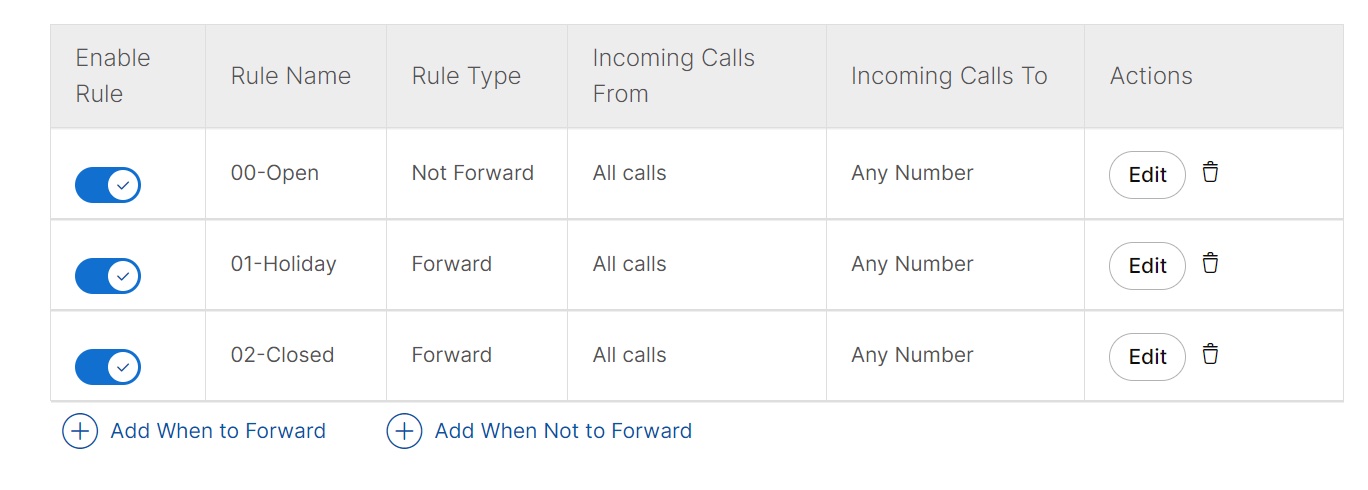
Aggiungere o eliminare utenti, spazi di lavoro e linee virtuali in un gruppo di ricerca esistente
| 1 | |
| 2 |
Vai a . |
| 3 |
Vai alla scheda Gruppo di ricerca e clicca su Gestisci. |
| 4 |
Seleziona un gruppo di ricerca da modificare. |
| 5 |
Fare clic su Agenti. |
| 6 |
Dal menu a discesa Aggiungi utente, area di lavoro o linea virtuale, seleziona gli utenti, le aree di lavoro o le linee virtuali che desideri aggiungere. Per eliminare i membri del gruppo di ricerca, fare clic su |
| 7 |
Fai clic su Salva. |
Modifica del gruppo di risposta di inoltro chiamata
Modificare il modello del modello di gruppo di risposta tra le opzioni disponibili.
| 1 | |
| 2 |
Vai a . |
| 3 |
Vai alla scheda Gruppo di ricerca e clicca su Gestisci. |
| 4 |
Seleziona un gruppo di ricerca da modificare. |
| 5 |
Fare clic su Modello di instradamento delle chiamate. |
| 6 |
Modificare le seguenti opzioni: Se si modifica il modello di instradamento delle chiamate da un modello che accetta 1.000 membri del gruppo di ricerca a un modello che accetta solo 100 o 50 membri, verranno mantenuti solo i primi 100 o 50 membri. Viene richiesto di confermare questa modifica quando viene apportata la modifica.
|
| 7 |
Fare clic su Aggiungi utente, area di lavoro o linea virtuale per modificare l'elenco degli agenti. |
| 8 |
Fai clic su Salva. |
Modifica delle gruppo di risposta di inoltro chiamata
| 1 | |
| 2 |
Vai a . |
| 3 |
Vai alla scheda Gruppo di ricerca e clicca su Gestisci. |
| 4 |
Seleziona un gruppo di ricerca da modificare. |
| 5 |
Fare clic su Opzioni di instradamento delle chiamate. |
| 6 |
Utilizzare i interruttori per attivare o disattivare ciascuna di queste funzioni.
|
Gestisci in blocco i gruppi di ricerca
È possibile aggiungere e gestire i gruppi di risposta in massa utilizzando un gruppo di risposta CSV.
Limitazioni note e requisiti
-
Prima di caricare il file CSV gruppo di risposta, accertarsi di leggere L'opzione Provisioning di massa e gli Webex Calling tramite CSV per comprendere le convenzioni CSV.
-
È possibile esportare i gruppi di ricerca correnti per aggiungere, eliminare o modificare il set di dati esistente oppure esportare un set campione di gruppi di ricerca. Dopo aver apportato le modifiche, puoi caricare il file tramite le funzionalità in blocco.
-
Esportazione del file CSV nel formato file ZIP: Quando si esportano dati in un file CSV, il numero di record può essere superiore a 1000. In questi casi, viene scaricato il file ZIP, che contiene l'intero set di record in un unico file CSV. Una cartella separata contenente tutti i dati è suddivisa in più file CSV con meno di 1000 record. Questi file vengono generati per fare in modo che gli amministratori importino rapidamente qualsiasi aggiornamento e caricamento.
-
Esporta un nuovo CSV per acquisire le informazioni più recenti sui campi ed evitare errori durante l'importazione delle modifiche.
-
-
È importante conoscere le colonne obbligatorie e facoltative e le informazioni da fornire quando si compila il modello CSV. Nella tabella seguente puoi trovare i campi specifici per il CSV del gruppo di ricerca.
-
Il numero massimo di gruppi di caccia per ogni località è 1.000.
-
Il numero massimo di righe è 1.000 (esclusa l'intestazione).
-
Gli agenti possono essere utenti o spazi di lavoro. Per gli utenti, inserisci l'indirizzo e-mail dell'utente. Per gli spazi di lavoro, immettere il nome dello spazio di lavoro.
-
Ogni riga può contenere un massimo di 50 agenti. Per ulteriori informazioni, vedi Aggiunta o modifica di più di 50 agenti alla volta.
Preparare il file CSV
Utilizza questa tabella per visualizzare i campi obbligatori e facoltativi e determinare ciò di cui hai bisogno quando aggiungi o modifichi gruppi di ricerca in blocco.
Le colonne sono campi obbligatori o facoltativi. Ciò varia a seconda che si utilizzi il CSV per aggiungere un nuovo gruppo di caccia o per modificarne uno esistente.
|
Colonna |
Obbligatorio o opzionale (Aggiungere una gruppo di risposta) |
Obbligatorio o opzionale (Modificare una gruppo di risposta) |
Descrizione |
Valori supportati |
|---|---|---|---|---|
|
Nome |
Obbligatorio |
Obbligatorio |
Inserisci il nome del gruppo di caccia. I nomi dei gruppi di caccia all'interno della stessa posizione devono essere identificabili in modo univoco. Se i gruppi di caccia si trovano in luoghi diversi, possono avere lo stesso nome. |
Esempio: Gruppo di risposta San Jose Lunghezza caratteri: 1–30 |
|
Numero di telefono |
Obbligatorio (se l'estensione è vuota) |
Opzionale |
Immettere il numero gruppo di risposta un altro numero di telefono. È necessario disporre di un numero di telefono o di un'estensione. |
Il sistema consente solo l'importazione CSV di numeri E.164. Esempio: +12815550100 Il numero di telefono deve essere nella scheda Numeri in Control Hub. |
|
Estensione |
Obbligatorio (se il numero di telefono è vuoto) |
Opzionale |
Inserire l'gruppo di risposta interno. È necessario disporre di un numero di telefono o di un'estensione. |
Estensione da due a dieci cifre. 00-999999 |
|
Posizione |
Obbligatorio |
Obbligatorio |
Inserire la posizione in cui assegnare questa chiamata gruppo di risposta. |
Esempio: San Jose La posizione deve essere riportata nella scheda Posizioni di Control Hub. |
|
Opzione Nome chiamante ID linea diretta |
Opzionale. |
Opzionale. |
Selezionare se si desidera utilizzare il nome visualizzato o un nome personalizzato come ID chiamante. |
_NOME DA VISUALIZZARE NOME PERSONALIZZATO_ Per impostazione predefinita è selezionato DISPLAY_NAME. |
|
NOME PERSONALIZZATO |
Opzionale. |
Opzionale. |
Inserisci un nome personalizzato per l'ID chiamante. Sono supportati i caratteri Unicode. |
Stringa |
|
Chiama per nome |
Opzionale. |
Opzionale. |
Inserisci il nome con cui puoi chiamare questo gruppo di ricerca. Sono supportati i caratteri ASCII. |
Stringa |
|
Lingua |
Opzionale. |
Opzionale. |
Inserire la lingua dell'annuncio per il gruppo di risposta. |
Esempio: en_us |
|
Fuso orario |
Opzionale. |
Opzionale. |
Immettere la gruppo di risposta del fuso orario. Questo fuso orario si applica alle pianificazioni applicate a questo gruppo di risposta. |
Esempio: America o Chicago Lunghezza in caratteri: 1–127 |
|
Sequenza di inoltro chiamata |
Obbligatorio |
Opzionale |
Immettere il percorso gruppo di risposta di indirizzamento del gruppo. Seleziona una delle policy supportate. |
CIRCOLARE, REGOLARE, SIMULTANEA, UNIFORME, SPESSO |
|
Avanza dopo l'abilitazione del numero di squilli |
Opzionale. |
Opzionale. |
Abilitare o disabilitare le chiamate in modo che avanzino dopo un numero impostato di squilli. Se questa opzione è abilitata, inserire il numero di squilli nella colonna successiva. |
TRUE, FALSE |
|
Avanza dopo la serie di squilli |
Opzionale. |
Opzionale. |
Inserisci il numero di squilli da attendere affinché l'agente attualmente assegnato risponda prima di assegnare la risposta al successivo agente disponibile. |
Intervallo: 1–20 |
|
Avanza se occupato abilita |
Opzionale. |
Opzionale. |
Se questa opzione è abilitata, il gruppo di ricerca non chiama gli agenti quando sono impegnati in un'altra chiamata. La chiamata avanza all'agente successivo nel gruppo di risposta. Se l'agente ha attivato la funzione di attesa di chiamata e la chiamata gli viene inoltrata, la chiamata rimane in attesa finché l'agente non torna inattivo. |
TRUE, FALSE |
|
Inoltro dopo attivazione squilli |
Opzionale. |
Opzionale. |
Abilitare o disabilitare le chiamate senza risposta da inoltrare a un numero di telefono designato dopo una serie di squilli. |
TRUE, FALSE |
|
Inoltra dopo squilli |
Opzionale. |
Opzionale. |
Inserire il numero di squilli da attendere prima di inoltrare al numero progettato. |
Gamma: 1–99 |
|
Inoltra numero |
Opzionale. |
Opzionale. |
Inserire il numero di telefono a cui vengono inoltrate le chiamate non risposta. |
Il sistema consente solo l'importazione CSV di numeri E.164. Esempio: +12815550100 Il numero di telefono deve essere nella scheda Numeri in Control Hub. |
|
Inoltro dopo squillo segreteria telefonica abilita |
Opzionale. |
Opzionale. |
Abilitare o disabilitare le chiamate senza risposta inoltrate a una casella vocale dopo un numero impostato di squilli. |
TRUE, FALSE |
|
Abilita gruppo di ricerca occupato |
Opzionale. |
Opzionale. |
Utilizzare questa colonna per abilitare o disabilitare il gruppo di ricerca occupato. |
TRUE, FALSE |
|
Consenti agli agenti di modificare lo stato di occupato del gruppo di ricerca |
Opzionale. |
Opzionale. |
Abilita o disabilita l'interruttore per consentire agli agenti di modificare lo stato di occupato del gruppo di ricerca. |
TRUE, FALSE |
|
Abilita deviazione quando occupato |
Opzionale. |
Opzionale. |
Abilita o disabilita la deviazione delle chiamate in caso di occupato verso un numero di telefono definito. |
TRUE, FALSE |
|
Devia quando numero occupato |
Opzionale. |
Opzionale. |
Inserisci il numero di telefono a cui deviare le chiamate quando le linee sono occupate. |
Esempio: +12815550100 |
|
Abilita deviazione se occupato |
Opzionale. |
Opzionale. |
Abilita o disabilita la deviazione delle chiamate in caso di occupato a una segreteria telefonica definita. |
TRUE, FALSE |
|
Deviare quando irraggiungibile abilitare |
Opzionale. |
Opzionale. |
Abilita o disabilita la deviazione delle chiamate non raggiungibili verso un numero di telefono definito. |
TRUE, FALSE |
|
Deviare quando numero irraggiungibile |
Opzionale. |
Opzionale. |
Inserisci il numero di telefono a cui deviare le chiamate quando non sei raggiungibile. |
Esempio: +12815550100 |
|
Deviare quando è abilitata la segreteria telefonica irraggiungibile |
Opzionale. |
Opzionale. |
Abilita o disabilita il trasferimento delle chiamate non raggiungibili a una segreteria telefonica definita. |
TRUE, FALSE |
|
Abilitazione gruppo di risposta |
Opzionale. |
Opzionale. |
Utilizzare questa colonna per attivare o disattivare il gruppo di risposta. |
ABILITATO, DISABILITATO, abilitato, disabilitato |
|
Suoneria differenziata numero alternativo - Abilita |
Opzionale. |
Opzionale. |
Abilita o disabilita la suoneria differenziata per i numeri alternativi. Se questa opzione è abilitata, inserisci lo squillo nella colonna Modello di suoneria numeri alternativi. |
TRUE, FALSE |
|
Azione numeri alternativi |
Opzionale. |
Opzionale. |
Inserisci ADD per aggiungere i numeri alternativi elencati in questa riga. Inserisci REMOVE per rimuovere i numeri alternativi elencati nella riga. Se inserisci SOSTITUISCI, rimuovi tutti i numeri alternativi inseriti in precedenza e li sostituisci con i numeri alternativi che stai aggiungendo solo in questa riga. |
AGGIUNGI, RIMUOVI, SOSTITUISCI |
|
Azione agente |
Opzionale. |
Opzionale. |
Inserisci ADD per aggiungere gli agenti elencati in questa riga. Inserisci REMOVE per rimuovere l'agente elencato nella riga. Se inserisci REPLACE, rimuovi tutti gli agenti inseriti in precedenza e li sostituisci con gli agenti che stai aggiungendo solo in questa riga. |
AGGIUNGI, RIMUOVI, SOSTITUISCI |
|
Consenti agli agenti di utilizzare il numero del gruppo di ricerca come ID chiamante |
Opzionale. | Opzionale. |
Abilitare l'interruttore per consentire agli agenti di utilizzare il numero del gruppo di ricerca come ID chiamante |
TRUE, FALSE |
|
Numero alternativo 1, Numero alternativo 2… Numero alternativo 10 |
Opzionale. |
Opzionale. |
Inserisci i numeri alternativi da assegnare al gruppo di ricerca. |
Esempio: 1112223333 Il numero di telefono deve essere riportato nella scheda Numeri di Control Hub. Lunghezza in caratteri: 1–23 |
|
Modello di anello alternativo numero 1, Modello alternativo di suoneria numero 2… Modello alternativo dell'anello numero 10 |
Opzionale. |
Opzionale. |
Se la suoneria differenziata è abilitata per i numeri alternativi, scegli il modello di suoneria differenziata. Scegli una delle opzioni supportate. |
NORMAL, LONG_LONG, SHORT_SHORT_LONG, SHORT_LONG_SHORT |
|
Agent1 ID, Agent2 ID… Agent50 ID |
Opzionale. |
Opzionale. |
Inserire gli agenti che si desidera assegnare al gruppo di risposta. Gli agenti possono essere utenti o spazi di lavoro. Per gli utenti, inserisci l'indirizzo e-mail dell'utente. Per gli spazi di lavoro, inserisci il nome dello spazio di lavoro. |
Esempio: test@example.com Lunghezza in caratteri: 1–161 |
|
Agent1 Weight, Agent2 Weight... Agent50 Weight |
Opzionale. |
Opzionale. |
Se il criterio di inoltro chiamata per il gruppo di risposta viene in base al peso, inserire la percentuale di peso dell'agente. |
Intervallo: 0-100 |
Aggiungi o modifica più di 50 agenti alla volta
Ciascuna riga può contenere un massimo di 50 agenti e il peso percentuale di indirizzamento chiamata associato (se applicabile). A gruppo di risposta un massimo di 1.000 agenti assegnati. Per aggiungere o modificare più di 50 agenti utilizzando il file CSV, seguire questi passaggi.
| 1 |
Inserire i 50 agenti e la percentuale di peso instradamento chiamata associata (se applicabile), che si desidera aggiungere o modificare nella prima riga per la gruppo di risposta si sta aggiungendo o modificando. |
| 2 |
Nella riga successiva, devi solo inserire le informazioni nelle seguenti colonne per aggiungere o modificare altri agenti:
Puoi lasciare vuote tutte le altre colonne. |
| 3 |
Continua a procedere in questo modo finché non avrai aggiunto tutti gli agenti che devi aggiungere o modificare. Un gruppo di risposta può avere un massimo di 1.000 agenti. |
Aggiungi in massa gruppi di risposta
Per aggiungere gruppi di ricerca in blocco, scarica e compila un modello CSV vuoto.
Non è possibile modificare in blocco le impostazioni di inoltro delle chiamate per un gruppo di ricerca. Per modificare l'inoltro di chiamata per un gruppo di ricerca, vedere Configurare l'inoltro di chiamata per un gruppo di ricerca.
| 1 | |
| 2 |
Vai a . |
| 3 |
Vai alla scheda Gruppo di caccia. Nella sezione Preferisci creare un gruppo di ricerca in un messaggio di massa, fai clic su Apri l'editor di massa. |
| 4 |
Viene visualizzata la finestra Gestisci gruppo di ricerca. Selezionare una posizione per il risposta per assente di risorse che si desidera aggiungere. |
| 5 |
Fare clic su Scarica dati o Scarica modello .csvper verificare che il file CSV sia formattato correttamente, assicurandosi di compilare le informazioni richieste. |
| 6 |
Carica il file CSV trascinandone la selezione o facendo clic su Scegli un file. |
| 7 |
Fare clic su Visualizza importazione history/Tasks per visualizzare lo stato dell'importazione CSV e verificare se si sono verificati errori. Una volta caricati correttamente, è possibile fare clic sulla pagina Visualizza attività per dettagli per visualizzare lo stato delle modifiche. |
Modifica in massa gruppi di risposta
Per modificare i gruppi di ricerca in blocco, scaricare i dati CSV correnti e apportare le modifiche necessarie al foglio di calcolo.
Non è possibile modificare in blocco le impostazioni di inoltro delle chiamate per un gruppo di ricerca. Per modificare l'inoltro di chiamata per un gruppo di ricerca, vedere Configurare l'inoltro di chiamata per un gruppo di ricerca.
| 1 | |
| 2 |
Vai a . |
| 3 |
Vai alla scheda Gruppo di ricerca e in Preferisci creare un gruppo di ricerca in un messaggio di massa, fai clic su Apri l'editor di massa. |
| 4 |
Selezionare una posizione per gruppo di risposta si desidera modificare. |
| 5 |
Fare clic su Scarica dati o Scarica modello .csvper verificare che il file CSV sia formattato correttamente, assicurandosi di compilare le informazioni richieste. Se i dati per il gruppo di ricerca selezionato superano il massimo (più di 10.000 righe per ogni CSV), riceverai un file compresso con più file CSV inclusi. |
| 6 |
Apporta le modifiche necessarie al foglio di calcolo. |
| 7 |
Carica il file CSV modificato trascinandone la selezione o facendo clic su Scegli un file. |
| 8 |
Fare clic su Visualizza importazione history/Tasks per visualizzare lo stato dell'importazione CSV e verificare se si sono verificati errori. Una volta completato il caricamento, puoi fare clic su Vedi pagina Attività per dettagli per visualizzare lo stato delle modifiche. |

